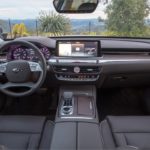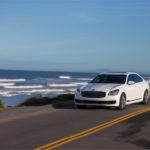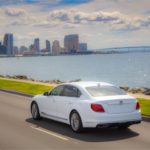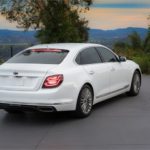By Jim Powell
What a surprise to schedule the newest Kia Forte and have a 2019 Kia K900 delivered to our location instead. The all-new 2019 Forte is financially more important to Kia but, in the meantime, I had to drive the composed and smooth K900 AWD through some of the heaviest rains California has experienced in years. It’s a tough job but someone has to do it!
- 2019 K900
- 2019 K900
- 2019 K900
- 2019 K900
After reviewing the Hyundai Genesis G80, Kia Cadenza, and many other sedans in this luxury category, it was amazing just unique this flagship K900 drives. Most automotive journalists are comparing the K900 against Mercedes E-Class, BMW 5-Series, Lexus GS, and Jaguar XJ due to its $60,000 price-point. I would hold the K900 up to the Mercedes S-Class, BMW 7-series, Audi A8, and the Lexus LS comparing interior space, ride quality, safety features, and even build quality.
In South Korea, the “K9” is a best-seller along the Pacific Rim, known as the Kia limousine for top executives. It offers the best of what Hyundai/Kia offers and stacks up well against world-class competition. Even though these competitors can cost over $100,000, this does not mean they are necessarily superior in the driving experience, materials, or even safety features. The K900 is clean, uncomplicated, planted on the road, and capable of speed. Furthermore, having an extra $40K to spend is more than a small bonus for the buyer.
Yet it was the US price tag of the 2015 V8 model that kept American buyers at bay. It may be hard to see in this 2019 refresh but Kia invested in proportioning the front grille, headlights, and rear end to improve the overall proportions. Grilles seem to be a big deal on luxury automobiles these days and new a “Quadric” signature grille has 176 jewel-like cells to catch the eye. The front fascia is more integrated compared to the last generation and is not overly “in your face” like some other manufacturers.
With some designers out of their California studio, Kia has redesigned the interior with a design language they call “The Gravity of Prestige.” This is a trans-pacific design philosophy that translates into a feeling of solidity and volume in an upscale space. Real walnut, ash, and engineered wood, high-grade aluminum, and soft leather/synthetic leather all complement each other everywhere a passenger lays their hands, elbows, and backside.
The cabin does not overwhelm the driver with too many screens, touchpads, switches or buttons. I do wish the row of switches (found in most Kia models) for climate and audio controls were not chrome-colored with white lettering. These need contrasting word colors for quicker looks while driving. The huge 12.3-inch center screen and intuitive steering wheel controls handled most of the needed adjustments.
Although the K900 has a lot of safety and convenience technology, my friend climbed in and immediately noticed the Maurice Lacroix clock centered between all the controls. A quality, eye-catching timepiece amidst all the modern features can add some prestige to any cabin. Admittedly, the digital dash that rearranges the instrument readout for each of the drive modes. The Pantone™ 64 mood colors (including Aurora Borealis) lighting from the overhead console, door panels, and front/rear foot-wells is all pretty cool.
The Heads-Up-Display (HUD) assists the driver with configurable information- while encouraging the driver to pay attention to the road. Kia does include a multi-function command knob like so many European sedans, but I never had to use it due to duplicate touch screen commands. For many, luxury is a feeling of stress-free control. When it comes to driving, less is more.
Since Asian countries use the K9 to wrap the rear seat VIP with a wide array of high-tech features and comfort amenities, it is tempting to let someone else drive. Tempting, yes, but not convincing for anyone who loves to drive. These passengers will enjoy up to 14 seat adjustments with the ability to recline, adjust headrests forward/aft, tilt cushions, warm or cool buns, and create their own climate and audio environment. Legroom is generous and the headroom is adequate for most people over 6’ tall.
K900 owners are also provided with a dedicated service representative reachable through a VIP phone line. There is a wireless cell phone charger in the front and rear and a wireless Apple CarPlay and Android Auto feature as well. There are no fold-down trays or fancy mustard bottles included but this is a great space for chauffeured adults or spoiled teenagers.
New for 2019 is the Stinger-inspired 3.3-liter turbocharged V6 engine, replacing the V8, and it won’t be missed. This twin-turbo V6 puts out 365 horsepower and a quickly generated 376 pound-feet of torque. The instant acceleration and lack of turbo lag had me rocketing up to speed so easily that I repeated the 30-70 mph test too many times. The Honeywell turbos are integrated into the exhaust manifolds and eliminate any hesitation related to typical turbo-lag. Even with my heavy right foot, I was able to record a real-world 23.8 mpg with 90 percent highway driving.
The standard full-time Dynamic Torque Vectoring Control (DTVC) All-Wheel Drive (AWD) system performed flawlessly. Development of this AWD came straight from the Kia Stinger and supports very spirited driving while transferring the electronically controlled power where it is needed most. This system can also distribute torque from side to side to aid in cornering.
When Sport mode is selected, up to 80 percent of the power moves to the rear, unless wheels are slipping. Sport mode also activates a stiffer suspension, quicker gear shifts, higher throttle responses, and even a driver seat bolster adjustment to hug the driver when activated. All this is highlighted with a large tachometer and a red instrument readout.
The transfer of torque while driving through inches of standing water was seamless and kept the K900 tracking true, even around sharp corners on a canyon road. Also, the 8-speed transmission found the right gear every time.
Rivaling or even surpassing other safety suites, Kia’s Advanced Driver Assistance Systems include their Surround View Monitor, giving a 360-degree perspective for slow-speed maneuvering. Also standard is a door lock override that keeps the occupant from opening the traffic-side door when there is an oncoming car. The Blind Spot View Monitor (BVM) uses cameras that instantaneously display a video image in the instrument cluster when changing lanes. Other standard equipment includes Lane Keep Assist System (LKAS), Forward Collision Avoidance Assist (FCA), and their driver attention monitor which advises the driver to stop the vehicle and get rest if it detects drowsiness or fatigue.
The automatic steering control is active when the Advanced Smart Cruise Control (ASCC) is engaged. Using lane markings and radar out the front of the sedan, this is one of the better systems, even during heavy rain. K900 is not designed for autonomous driving and the driver needs to stay engaged but this sedan can reduce stress and fatigue during conditions I experienced.
As for livability, one should be so lucky as to “live” in this car for long periods of time. The 20-way adjustable driver’s seat design achieves comfort with standard quilted Nappa leather. The trunk is huge and can store more luggage than needed or even walkers and wheelchairs, which many manufacturers have overlooked in recent years. After all, people who can afford such luxury might just need some assistance when getting out of the car.
There is a modem-based Premium Navigation6 system which comes with features accessible via Kia’s UVO luxe1 sub-brand, dedicated exclusively to K900 owners. UVO luxe1 offers a full suite of remote features and telematics accessed from desktops, tablets, or dedicated UVO luxe1 apps. These access points allow for remote starts, setting cabin temperatures, or even “Find My Car.” All of this luxury is surrounded by a 900-watt 17-speaker Lexicon audio system featuring Kia’s QuantumLogic Surround Sound. This sound system has to be heard to be appreciated.
Even though the 2019 K900 has a longer wheelbase and a wider stance, it has more body rigidity with increased front and rear lateral stiffness. Through more adhesives and four times more hot stamping than the previous model, the new K900 is a very solid platform. Torsional stiffness increased by 33 percent over the outgoing K900, helping to give the vehicle a more solid and premium on-road feel.
At the same time, the K900’s handling was tweaked by Albert Biermann, president of Kia’s Vehicle Test and High-Performance Development. “The goal for the K900 was to achieve ‘confident comfort’ on the road,” stated Biermann. “To deliver this result, we focused on four main categories: drivability, NVH, comfort and steering precision.” They tuned the electromechanical, rack-mounted power steering assembly to near perfection.
Obviously, I am impressed with this flagship sedan. There are some annoying sensors and sounds frequently coming from the dash and the driver-assist computer systems reengage every time one starts the car. Overall, the 2019 Kia K900 is a beautiful premium sedan offering great value. Kia’s flagship might not stay in the US market for long but the success of the Kia Telluride might bring enough higher-end buyers through the showroom to change some people’s minds.





